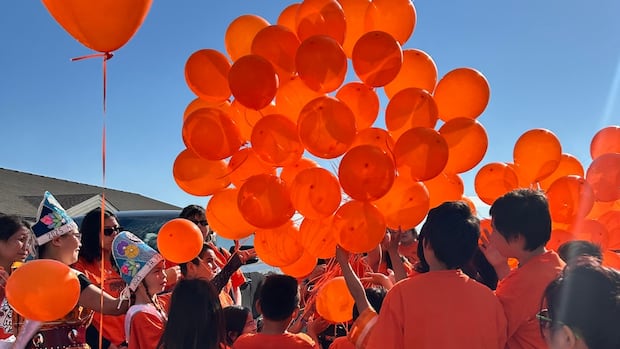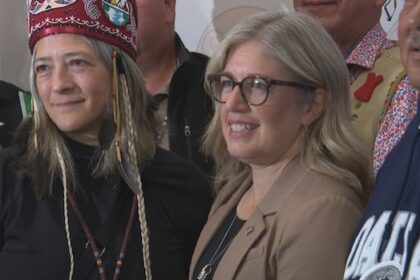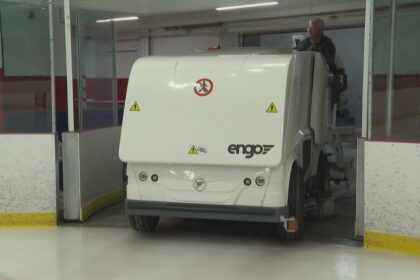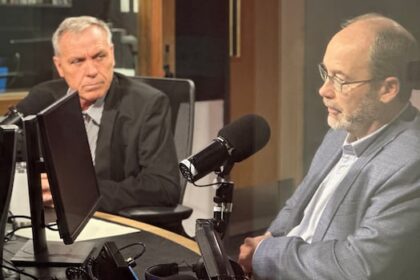ManitobaOver 50 orange balloons were released into the sky over Opaskwayak Cree Nation after the community’s Every Child Matters walk on Tuesday — an act of closure as Canadians gather across the country to remember the dark legacy of residential schools.’You have to let go, because it always lingers inside your body,’ residential school survivor saysOzten Shebahkeget · CBC News · Posted: Sep 30, 2025 5:53 PM EDT | Last Updated: 3 hours agoChildren gather to collect orange balloons after Opaskwayak Cree Nation’s Orange Shirt Day walk on Tuesday. (Özten Shebahkeget/CBC)Over 50 orange balloons were released into the sky over Opaskwayak Cree Nation after the community’s Every Child Matters walk on Tuesday — an act of closure as Canadians gather across the country to remember the dark legacy of residential schools.More than 100 people dressed in orange walked from Gordon Lathlin Memorial Centre to Opaskwayak’s Veterans’ Hall on Tuesday morning.Outside the hall, community members dropped items into a sacred fire as part of a “letting go” ceremony. It was a chance for residential school survivors, intergenerational survivors and other members of the community to let go of the past by burning things in the fire.Some burned material things that had negative emotions tied to them, others burned tobacco and offered prayers.Once that was done, the ceremony ended in a hopeful display with the balloon release. Children were told to pray for healing as they let go.Esther Crane, who has family members who went to residential schools, said letting go of the tobacco and the balloon was emotional for her.”You could feel that sense that you let go of something that you’ve carried for a long time,” she told CBC News. “I felt the pride and the joy and the spirit of releasing it. It took a lot of my negative energy away.”Attendees watch after over 50 balloons were released into the sky after the Orange Shirt Day walk in Opaskwayak. (Felisha Adam/CBC)Canadians are gathering for ceremonies and reflecting on the tragic legacy of residential schools — and honouring the children who never came home — as the country marks the fifth annual National Day for Truth and Reconciliation.It’s also known as Orange Shirt Day, in honour of Phyllis Webstad, whose orange shirt — given to her by her grandmother — was taken away from her on her first day at a B.C. residential school in 1973.The day was marked as a statutory holiday for the first time in Manitoba last year.More than 100 people walked in the march on Tuesday. (Özten Shebahkeget/CBC)Edwin Jebb, a member of Opaskwayak, was a student at Guy Hill Indian Residential School for nine years, starting when he was six, in 1957. The school was near Clearwater Lake, where The Pas Airport stands today.”It was a terrible place to be, especially as a child,” Jebb said.No one he knew talked about their experiences at the school after they got out, because they were “former little inmates coming from a prison” and didn’t want to hurt their loved ones.But things have changed over the decades, and Jebb has let go of the hurt and anger he felt at Guy Hill, he said.”You can’t forget it, because it’s always there in the back of your head,” he said. “You have to let go, because it always lingers inside your body. Otherwise, it’ll eat you away.”Edwin Jebb was a student at Guy Hill Indian Residential School for nine years, starting when he was six years old in 1957. (Felisha Adam/CBC)Jebb went to the march to show support for other survivors and the young people in the community. The prevalence of drugs and violence, incarceration and child welfare agencies in Indigenous communities shows younger generations are impacted by the schools too, he said.”We got to work on that, and a lot of it stems from the fact that we didn’t know how to be parents.”There’s more work to do, and Jebb says reconciliation is more important now than ever.”We’ve told the truth for years and years, [and] some people are only now hearing about the truth.”‘We survived’Kim Young’s father was a residential school survivor and many of her aunts and uncles also were forced to attend residential schools or day schools.When she was a child, Young and her father once walked past the site of what is now Opaskwayak’s Joe A. Ross School, and she was confused when she noticed her father tearing up.He said he was happy that his children would have their own school.”I’m going to be thinking about the freedom that we have, that they didn’t have,” she said.”We’re here today. We survived.”Kim Young, right, went to the march with her son, Danny. (Özten Shebahkeget/CBC)Frank Young, a councillor for Opaskwayak, which is about 520 kilometres northwest of Winnipeg near the Saskatchewan border, told the crowd at the hall that he was forced to go to Michael’s Indian Residential School in Duck Lake, Sask., but he ran away after one day there.”I was back home the next day, but for the thousands of kids who didn’t get the chance to run away, that’s what we’re here for today,” he said.He urged people to ensure their children remember those who didn’t make it home.”They’re never forgotten.”Brenda Bignell, a survivor of the Sixties Scoop — the government’s removal of Indigenous children from their homes during the late 1950s to the 1980s, many of whom were adopted into non-Indigenous families — said she wanted to march for other survivors and for herself.”It is something that I still, unfortunately, dream about, which is really sad, [but] hopefully, this walk will help,” she told CBC News before the march began.Her advice to other survivors struggling to heal from the past is to “start somewhere.””Take it day by day. Take baby steps. Talk to someone you trust and you love.”With files from Felisha Adam
Monday, 17 Nov 2025
Canada – The Illusion
Search
Have an existing account?
Sign In
© 2022 Foxiz News Network. Ruby Design Company. All Rights Reserved.
You May also Like
- More News:
- history
- Standing Bear Network
- John Gonzalez
- ᐊᔭᐦᑊ ayahp — It happened
- Creation
- Beneath the Water
- Olympic gold medal
- Jim Thorpe
- type O blood
- the bringer of life
- Raven
- Wás’agi
- NoiseCat
- 'Sugarcane'
- The rivers still sing
- ᑲᓂᐸᐏᐟ ᒪᐢᑿ
- ᐅᑳᐤ okâw — We remember
- ᐊᓂᓈᐯᐃᐧᐣ aninâpêwin — Truth
- This is what it means to be human.
- Nokoma












